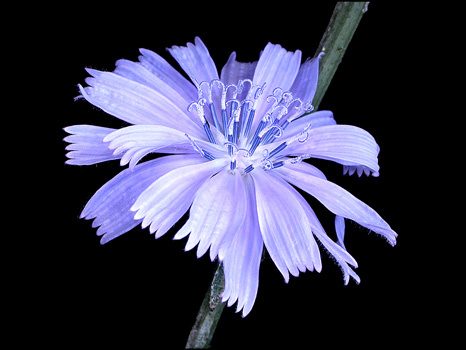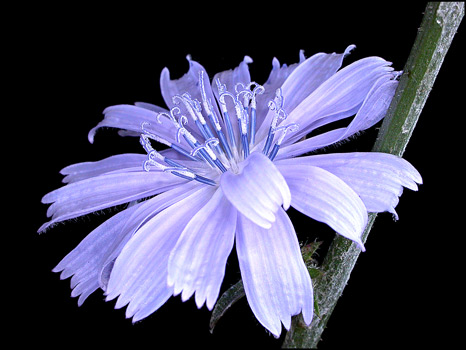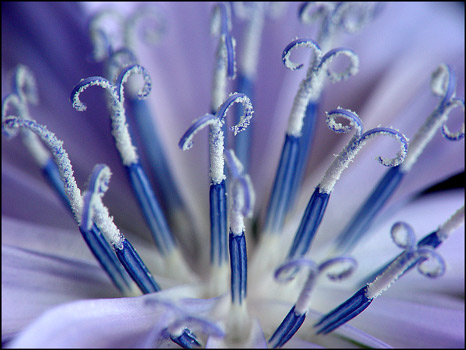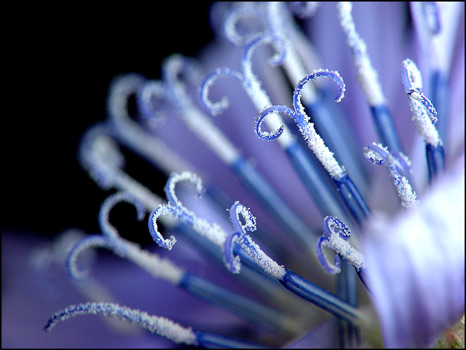 |
A Closeup View of the Common Wild Flower Chicory
(Cichorium intybus)
by Brian Johnston (Canada) |
 |
A Closeup View of the Common Wild Flower Chicory
(Cichorium intybus)
by Brian Johnston (Canada) |
With the introduction of the digital camera, macrophotography has become easier for amateur photographers. Many such cameras have a dedicated macro mode which allows the subject to be in focus as close as a couple of centimetres from the lens. In this brief article I will show the results of using a Nikon Coolpix 4500 (4 megapixel) and Sony CyberShot DSC-F717 (5 megapixel) to investigate a common weed.
The light blue flowers of the chicory plant stand out, not only because of their unusual colour, but also because they are held aloft on stems that can be more than a metre high. The plant seems to grow in the most inhospitable locations where there is little moisture in the soil. My samples were growing out of cracks in the concrete sidewalk beside a busy four lane highway. Chicory originated in Europe, but was transported to North America. Its root, when roasted and ground up, was used instead of coffee, when coffee was in short supply during World War II. It had the benefit of containing no caffeine.
Since the surroundings of the growing plants were definitely not photogenic, I decided to remove parts of the stem containing flowers and to carry them home to photograph in a more controlled environment. Originally, I attempted to use black cardboard to provide a dark background, but I soon found that the surface was shiny enough to reflect ambient light from the room. This resulted in shades of black and gray instead of a truly dark background. The solution was to cover an old picture frame with black velvet. This background could be positioned at any angle and was completely free of any intrusive reflections. The camera was positioned about twenty centimetres above the table on a small but sturdy tripod. A clamp was used to hold the stem containing the flower at the required angle.
The flower photograph at the beginning of the article, and the three below were taken with the Coolpix 4500 using light from a nearby window and the Nikon Cool light SL-1 to illuminate the 3 cm diameter flower. (The Cool light uses a ring of white LED's powered by a battery and screws into the filter threads on the camera lens.) In order to obtain the maximum depth of field, the aperture priority mode was used with the f-stop about f8. This resulted in exposures of between 1/4 and 1 second with the available lighting. The pollen covered stigmas are clearly visible in the last two photographs.




In order to get higher magnifications, I used the Sony F 717 equipped with an accessory achromat which screws into the 58 mm filter threads of the camera lens. Such an add-on lens has the added advantage of providing more working room between the subject and camera. In this case the flower was about 14 cm from the front of the lens. It proved much easier to illuminate the subject with natural light using this setup. Again, aperture priority mode was used with an f-stop of about f10.



The next two images are "rough and ready" photomicrographs taken using a Leitz SM-Pol microscope equipped with a dark field condenser, and the Coolpix 4500. Tweezers were used to pull a stigma from the flower. The stigma was then placed uncovered on a microscope slide and photographed. In the second image the dimpled surface of one of the lobes of the stigma is clearly visible.


A water mounted stigma was photographed using a phase contrast condenser and Leitz NPL Fluotar 25/0.55 PHACO 2 objective. The image below shows two of the protuberances that can be seen in the first of the dark field images.

Smaller protuberances can be observed on the surface of the tube immediately below the two curling lobes of the stigma.

A single pollen grain showing the spiny surface can be seen in the image below.

The focus was adjusted in this last image in an attempt to show what looks to be larger scale, more regular protuberances on the pollen grain.

I have found that photographing wild flowers is both entertaining and educational. When observed on a macroscopic scale, flowers display even more of their intrinsic beauty to the observer. Sometimes even zoology joins botany when the tiny creatures that live on the plants drop onto the table while you are photographing! It's amazing the range of wildlife that makes a home of a flower. In fact, the only disadvantage that I have found to my new hobby is the very strange looks that passersby display when they see me carrying home "bouquets" of weeds. (Perhaps if I lived in the country, instead of a large city, this would not be the case!)
All comments to the author Brian Johnston are welcomed.
Please report any Web problems or offer general comments to the Micscape Editor.
Micscape is the on-line monthly magazine of the Microscopy
UK web
site at Microscopy-UK